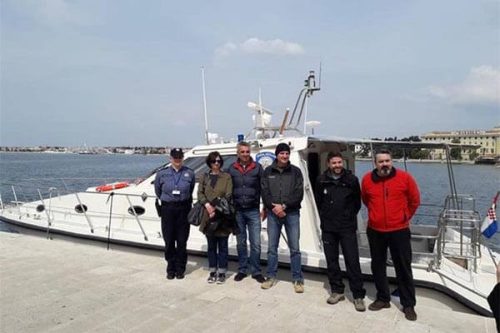ANCIENT SHIPWRECK MOLAT
An ancient shipwreck in the seabed of the island of Molat was discovered in 2017 and was reported to the Department of Underwater Archeology of the Croatian Restoration Institute. The shipwreck dates back to the 1st century, and it was carrying a load of ancient construction material - tegula and imbrex. It was declared a protected cultural asset of the Republic of Croatia in 2019.
Author:
Pavle Dugonjić
On the morning of April 9, 2019, a professional survey of the reported underwater archaeological site was carried out near the island of Molat. The site was reported by members of the Diving Club ZG-SUB (today's Wreck Hunters Adriatica) at the end of 2017.
Near the island of Molat, an ancient shipwreck was found with a load of tegules and imbrex.
After confirming the location, in 2019, the process of recording the cultural property was initiated. The site is located at a depth of 20 meters in the immediate vicinity of the island and is available for archaeological research. It covers about 80 square meters, and at the bottom is visible the cargo of the ancient shipwreck, which contains several hundred bricks and individual specimens of imbreks (antique tiles and cones) that sank to the bottom during transport. Other findings were also
observed at the site. Fragments of ceramic dishes that probably belong to the ship's galley were found, as well as one neck of an amphora of the Dressel 6A type (from the 1st century). Underwater archaeologists documented the condition of the site upon discovery, took basic measurements of the site, weights (dimensions of tegules and imbrexes) and other data from which a 3D model will be formed. Expert supervision was carried out by Igor Miholjek (Head of the Underwater Archeology Department of the Croatian Restoration Institute), Dino Taras (Head of the Underwater Archeology Department of the Archaeological Museum in Zadar), Zadar sub-regional unit within the Coordination for the Protection of the Rights and Interests of the Republic of Croatia at Sea, Barbara Peranić (senior conservator in the Zadar Conservation Department - Ministry of Culture of the Republic
of Croatia), Zoran Delibašić and Dragutin Šimatović (divers of the ZG-SUB Diving Club, external collaborators of the Department of Underwater Archeology of the Croatian Restoration Institute) and employees of the Zadar Maritime Police with their vessel.
First findings
The first finds of sunken building material on the eastern coast of the Adriatic date back to the seventies of the last century, when the locations of the found ancient shipwrecks with building material stretched from the north to the extreme south of the Croatian coast. It is important to distinguish individual finds from those belonging to ship cargo, as we can see in the example of individual finds of amphorae that were discarded after use or in the example of individual finds of construction material that could have been deposited on the seabed for many reasons. It is precisely the abundance of →
→ finds, their arrangement on the seabed, and the existence of remains of the ship's structure (along with many other indicators) that point to the discovery of ship's cargo.
Deposits of tegules, imbrexes and
building elements in the Adriatic Sea
In Bijar bay on the island of Cres, many fragments of tegules and imbrexes were observed, but their origin is unknown because they have no evidence of seals. There are several sites with tegules on Lošinj: the site near Cape Madona (Čikat-Plocice) and sporadic tegules in Liska Bay. At the site near Cape Margarin on Susak, in addition to loads of teguls and imbreks, a load of larger building elements was also recorded, namely half-finished stone blocks and about twenty finished round stone pillars lying at a depth of about 30 meters, creating a very impressive scene. although covered in underwater flora and fauna. Apart from them, ten or so sites with this type of building material have been defined in Croatia, even more on land, and the newly discovered site in Molat can finally be added to that list. The amount
of tegulls at the site in Molat is imposing, and the tegulas are glued in the same position as they were placed in the ship's hold. Given the shape of the sunken cargo, it is possible to assume that there is a ship structure under the cargo, the research of which would certainly give archaeologists valuable information about shipbuilding in the Roman era. In addition to a large amount of tegulas and individual pieces of im-brex, one neck of a Dressel 6A amphora (from the first century) and small fragments of fine ceramics that probably belong to the ship's galley were also found.
Rich commercial activity of
the eastern coast of the Adriatic
We hope that future research will yield more valuable information! Until then, we conclude that the number of sites of this type with the discovery of construction materials indicates a rich trade activity and the existence of maritime routes that abounded on the eastern coast of the Adriatic in ancient times. Unfortunately, despite the relatively large number of underwater sites of this nature,
knowledge about them is not at an enviable level. At known sites of this type, only primary documentation was carried out after the find or upon notification by the persons in charge, and more detailed research was not carried out, considering that the building material was not considered an attractive find. However, despite this, the primary archaeological documentation of the found state was carried out at the site near Molat. The entire site was photographed in order to use the photos to create a locally referenced 3D model of the site. This method of documentation is completely non-invasive and enables a detailed insight into the condition of the site, measurement of the dimensions of individual parts of the site, as well as the determination of the number of existing and visible parts lying on the seabed - without the need for re-diving to the seabed. Nevertheless, every underwater archaeologist looks forward to returning to the blue depths that hide such interesting finds! The use of photogrammetry techniques is gaining momentum and serves as an indispensable tool in documenting sites and monitoring changes in their condition.











